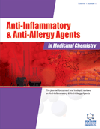- Home
- A-Z Publications
- Anti-Inflammatory & Anti-Allergy Agents in Medicinal Chemistry (Formerly Current Medicinal Chemistry - Anti-Inflammatory and Anti-Allergy Agents)
- Previous Issues
- Volume 5, Issue 1, 2006
Anti-Inflammatory & Anti-Allergy Agents in Medicinal Chemistry (Formerly Current Medicinal Chemistry - Anti-Inflammatory and Anti-Allergy Agents) - Volume 5, Issue 1, 2006
Volume 5, Issue 1, 2006
-
-
Editorial [ Cellular and Molecular Mechanisms of Action of Drugs Affecting Inflammatory Leukocyte Function (Guest Editor: P.X. Elsas)]
More LessBy P. X. ElsasWhile it is often repeated that one cannot teach an old dog new tricks, it is likely that one can learn new tricks even from an old dog; and the same is certainly true for old drugs, as abundantly illustrated by the review articles in this special issue of Current Medicinal Chemistry. Even though most of them deal with very timely issues of cellular and molecular mechanism in the context of inflammation, much of the information discu Read More
-
-
-
Granulocyte Apoptosis and Macrophage Clearance of Apoptotic Cells as Targets for Pharmacological Intervention in Inflammatory Diseases
More LessA subset of leukocytes, known as the granulocytes, are the body's first line of innate immune defense. The granulocytes are comprised of neutrophils, eosinophils and basophils of which the former two will be the focus of this review. Neutrophils defend the body against bacterial and fungal infection whilst eosinophils are thought to defend against parasitic invasions. Granulocytes are recruited to the site of infection or Read More
-
-
-
Anti-Inflammatory Drug Effects on Apoptosis of Eosinophil Granulocytes Derived from Murine Bone-Marrow: Cellular Mechanisms as Related to Lineage, Developmental Stage and Hemopoietic Environment
More LessAuthors: Maria I. C. G. Elsas and P. X. ElsasThe effects of a variety of widely used anti-inflammatory agents (dexamethasone, indomethacin, and montelukast) as well as ubiquitous mediators of inflammation (prostaglandin E2 and nitric oxide) on the development of murine eosinophils ex vivo and in vivo have been studied over the last decade. The results indicate that developing eosinophils differ markedly in their responses to these agents from the mature forms of the Read More
-
-
-
Apoptosis and Atherosclerosis: The Role of Nitric Oxide
More LessAuthors: Catherine A. Shaw, Ian L. Megson and Adriano G. RossiAtherosclerosis, and its associated complications, are a major cause of morbidity and mortality, and it is now recognised as a chronic inflammatory disorder. Progression of inflammation depends on the balance between recruitment of inflammatory cells and their subsequent removal from a site of inflammation. Apoptosis, or programmed cell death, is a fundamental process governing cell survival and is a major determinant of t Read More
-
-
-
Inflammatory and Vascular Alterations in Sepsis: The Role of Nitric Oxide- Dependent Mechanisms
More LessSepsis and septic shock continue to be a major cause of morbidity and mortality in critically ill patients. During the onset of sepsis, a massive inflammatory reaction is mediated via cell-derived cytokines and chemokines that target end-organ receptors in response to injury or infection. Polymorphonuclear leucocytes are critical effector cells during the inflammatory process and their migration to the infectious focus is ex Read More
-
-
-
Modulation of Eosinophil Functions by Nitric Oxide: Cyclic GMPdependent and -independent Mechanisms
More LessAuthors: Heloisa H.A. Ferreira, Nicola Conran and Edson AntunesRecruitment of eosinophils into tissues is a feature of a variety of allergic diseases, including asthma and nasal allergy. Eosinophils secrete several preformed granule proteins (eosinophil peroxidase, major basic protein, eosinophil cationic protein and eosinophil-derived neurotoxin) and newly-generated substances (oxygen-derived toxic metabolites, lipid mediators, cytokines and chemokines), which may contribute to the exac Read More
-
-
-
Signaling Pathways Involved in Leukocyte Adhesiveness and Migration during Inflammation: Potential Targets for Therapeutic Interventions?
More LessIn response to a chemotactic gradient of inflammatory mediators and chemokines, neutrophils adhere to vascular endothelium and directly migrate, leaving blood vessels, toward inflamed tissue areas, to exert their primary defense function. These events are mediated by distinct classes of cell surface receptors in human neutrophils, that not only drive cell adhesion and motility, but also interfere with the cell's activation s Read More
-
-
-
Thalidomide: An Overview of its Pharmacological Mechanisms of Action
More LessNovel discoveries in medicine have provided understanding of the mechanisms involved in the development and maintenance of pathologies, thereby leading to the identification of new therapeutic targets and consequently new drugs. Thalidomide, independently of its teratogenic effects, is one drug able to regulate the immune system. Deeper studies about thalidomide have started on the 90's, when some of its action m Read More
-
-
-
Thalidomide and Analogs as Anti-Inflammatory and Immunomodulator Drug Candidates
More LessThalidomide ([2-(2,6-dioxo-hexahydro-3-(R,S)-pyridinyl)-1,3-isoindolinedione]), well known by its teratogenic effect, caused birth defects in up to 12,000 children in the 1960s. More recently, this drug was approved by the US Food and Drug Administration for the treatment of erythema nodosum leprosum, under restricted-use program, and a variety of new possible therapeutic applications have been described. This arti Read More
-
Volumes & issues
-
Volume 24 (2025)
-
Volume 23 (2024)
-
Volume 22 (2023)
-
Volume 21 (2022)
-
Volume 20 (2021)
-
Volume 19 (2020)
-
Volume 18 (2019)
-
Volume 17 (2018)
-
Volume 16 (2017)
-
Volume 15 (2016)
-
Volume 14 (2015)
-
Volume 13 (2014)
-
Volume 12 (2013)
-
Volume 11 (2012)
-
Volume 10 (2011)
-
Volume 9 (2010)
-
Volume 8 (2009)
-
Volume 7 (2008)
-
Volume 6 (2007)
-
Volume 5 (2006)
Most Read This Month
Article
content/journals/aiaamc
Journal
10
5
false
en


